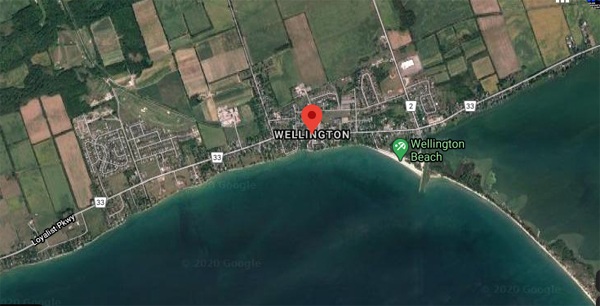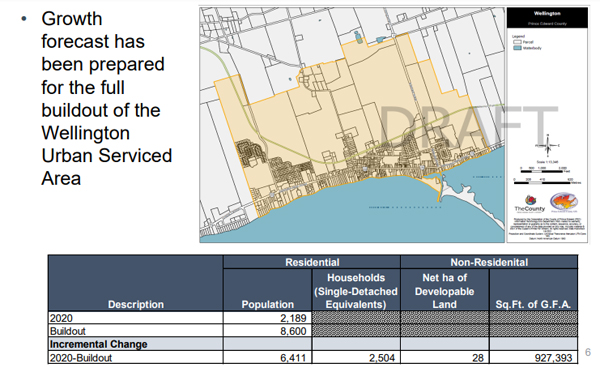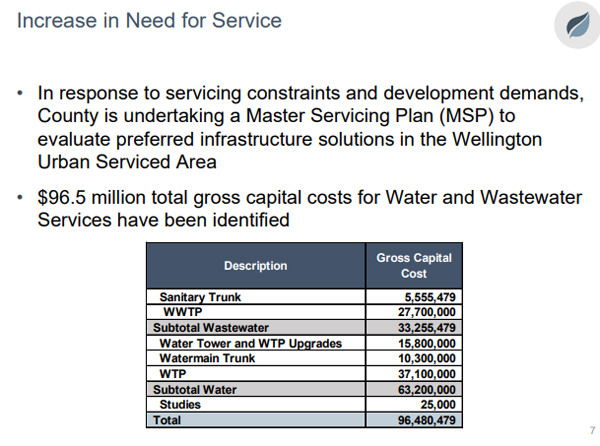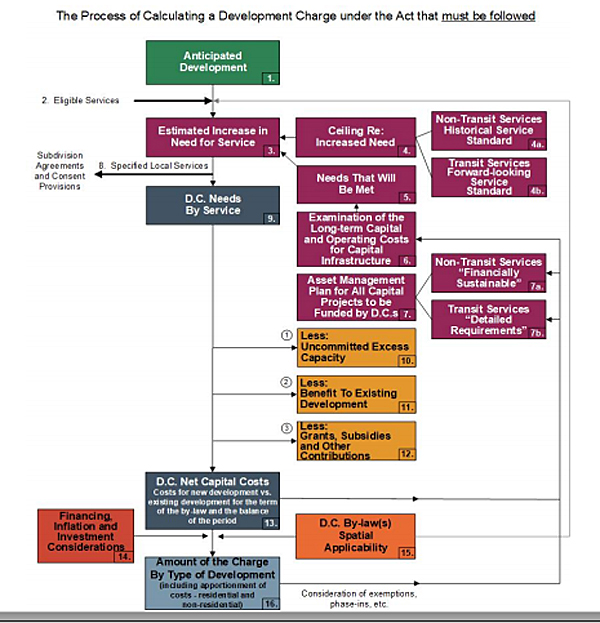Big numbers, big decisions to serve current and future residents of Wellington
Administrator | Jan 15, 2021 | Comments 6

Wellington – Google maps satellite image
By Sharon Harrison
The municipality is tackling how to solve current and future problems with development in Wellington, at enormous cost.
A lot of big numbers were bandied about at Thursday’s virtual Committee of the Whole meeting as council heard a report on a Wellington-specific development charges background study.
The crux is an Official Plan and a Secondary Plan that permit growth that cannot currently be serviced by water and sewer. That, says the municipality’s Chief Administrative Officer is the reason for the study, to help address that gap.
“We see that there is risk now with an Official Plan and a Secondary Plan that permits growth that we cannot service under the current situation, so we cannot approve any more development even though our Secondary Plan says it’s allowed,” said Marcia Wallace. “Eventually, we will be having a legal risk not just a financial one for not meeting our obligations to match up with our own planning framework,” added Wallace.
The challenge is looking at anticipated capital needs of $96.5 million – about $75.6 million would be recoverable in development charges eligible costs and County ratepayers would be on the hook for $20 million.
“I know a lot of the public in Wellington are shocked that we would spend close to $100 million with the expectation that there would be 8,600 people here someday,” said Wellington councillor Mike Harper.

Andrew Grunda, Watson and Associates
The municipality retained Watson & Associates Economists Ltd. in September 2020 to prepare the study. Representative Andrew Grunda gave an overview, and brief presentation, of the study findings.
Grunda explained the municipality currently imposes charges for water and wastewater services through a connection charges bylaw on a County-wide basis.
The intent of using an area-specific development charge (DC) bylaw for this purpose is to address and facilitate the servicing requirements for the Wellington community for water and waste water.
“And to do so through this mechanism as a funding tool for a potential up-front funding arrangement,” said Grunda. “It also reflects council’s intent that occurred through the 2017 water and wastewater ad-hoc committee, as well as the 2018 DC background study that has been prepared for the County which sought to incorporate water and wastewater in the development charges realm.”
 He noted anticipated development for the Wellington urban serviced area, as determined by the County’s master servicing plan, identifies growth over the full development would facilitate approximately 2,500 additional single detached equivalent units – adding about 6,400 people – about triple the existing population.
He noted anticipated development for the Wellington urban serviced area, as determined by the County’s master servicing plan, identifies growth over the full development would facilitate approximately 2,500 additional single detached equivalent units – adding about 6,400 people – about triple the existing population.
Grunda said non-residential development would be facilitated through the construction of industrial, commercial and institutional needs on approximately 28 net hectares of developable land. It is expected that approximately 927,000 square feet of gross floor building area of non-residential development would be required.
The master servicing plan also identified the water and wastewater needs to facilitate such growth.
“With the preferred infrastructure solution of that plan, it is identified that approximately $96.5 million in water and wastewater capital needs would be required.”
About a third of the $96.5 million would be required for the waste water system, with about two-thirds for the water system.
 “Combined water and wastewater treatment plants account for about 67 per cent of the total cost, or just under $65 million,” said Grunda. “The remaining third of those costs would be the infrastructure for the purposes of distribution and collections, and the associated studies.”
“Combined water and wastewater treatment plants account for about 67 per cent of the total cost, or just under $65 million,” said Grunda. “The remaining third of those costs would be the infrastructure for the purposes of distribution and collections, and the associated studies.”
About $46 million (48 per cent) would be attributable to residential development, with non-residential representing about 30 per cent ($30 million).
About 19 per cent ($19 million) would benefit existing development for the replacement of the current demands for the water and wastewater treatment plant – that would be facilitated by the new plants as well as addressing current level of service issues and storage and water pressure demands.
The water treatment plant is identified to be built in two phases, the first representing about $23 million, expected to be built between 2021-2024 and that the second phase would be much later, close to 2042.
Grunda said some of the infrastructure would be required immediately, or in the near term.
Wellington councillor Harper clarified what residents may have to contribute to the expansion and what the future may look like. He confirmed of the $96 million, the County is on the hook for about $20 million.
“If we were not to use all 28 hectares for non-residential, if for some reason we were not able to attract that kind of business, that still has to be covered: the shortfall there would have to be made up somehow,” he said.
Picton councillor Kate MacNaughton was interested in the impacts to ratepayers and the importance of communicating with the public.
“Looks like we are taking on an enormous amount of risk and I really don’t know if there are enough ways to offset this risk that would give me confidence,” she said. “I’m not even clear if the full plan for servicing Wellington necessarily meets my vision of Wellington’s future long-term.”
MacNaughton was concerned whether the County would be communicating directly with ratepayers through water bill mailings so they know about future meetings and are aware of the risks being considered which will be borne by them.
“As there is so much risk here that to one extent or another is going to be borne by ratepayers. They are already stretched.”
CAO Wallace said they are in the process of having conversations around an upfront financing agreement for the four largest developments.
“We are hoping to have a draft agreement before we come to council on the 25th, so we have a better idea of how this might impact.”
She noted the municipality is looking at every possibility to get the majority of the development to be financed through something alterative, “so the municipality isn’t carrying the full weight of the risk of ‘build it and hope they will come’.”
Sophiasburgh councillor Bill Roberts raised the issue of public involvement and risk and was concerned there hadn’t been a good discussion on the appropriate governance related to Wellington development charges as they relate to water and wastewater.
“Wellington water consumers are largely left out of the governance and management of their own water utility that they are using and they pay the entire bill,” Roberts said. “These are huge numbers with huge risk involved.”
“These numbers are staggering,” said Ameliasburgh councillor Janice Maynard, who asked about considering recalculating less than a full build out. “The risk is too high.”
Jamie Forester, councillor for Athol was concerned growth would slow down in the next two years once out of the pandemic.
“What happens if we don’t do it?” he asked. “What if we don’t get the growth over the next 20 years?”
Andreas Bolik, councillor for Ameliasburgh reminded “we have a problem in maintaining the infrastructure we have now. We need to re-examine where exactly growth should happen in the County.”
Grunda also addressed the proposed schedule of charges per residential dwelling unit type, and per square foot of gross floor area for non-residential building construction.
For a single detached dwelling of more than two bedrooms, the total new proposed charge would be $21,367 (current charge is $11,152); less than two bedrooms would be $15,000.
Apartments with a minimum of two-bedrooms would be $14,316, apartments with two bedrooms or less $9,875.
The non-residential charge would be $34.14 (current charge is $5.53) per square foot of gross floor area constructed.
Grunda noted an increase of roughly $10,000 per residential unit for single detached dwelling of two bedrooms or more.
“The reason for the more significant increase in non-residential is reflective of the underlying services demands inherent in the master servicing plan.”
Development charges would be payable at the time of building permit issuance which Grunda said was fairly customary.
The only exception being for rental housing or institutional development where development charges are paid over six installments over five years. Likewise, non-profit housing is to be paid over 21 installments over a 20-year period.

The development charges bylaw is to come before council on Feb. 25 for consideration/adoption. The development charges background study documentation and a video of the meeting can be found at the County’s website.
Filed Under: Featured Articles
About the Author:

































I agree. Everyone comes to town for groceries, banking, health care, recreation, dining, household supplies, booze, etc etc. But the water and wastewater infrastructure is on the the backs of the urban residents. Not fair at all. Where would all these people go if urbanites were not providing such at unsustainable costs?
If the County recommends this and needs this for future growth then the costs should be shared through the general tax base. I feel that Wellington and Picton residents are a little wallet weary in providing urban playgrounds and essential services for non urban residents.
Proposed Wellington Water Tower
I was shocked to hear that a new water tower was being erected in the parking lot just south of the New Wellington Arena on the corner of First Ave and Belleville Street. Construction is to begin before the completion of 2021.
Council had an engineering study completed in 2018 which identified the Wellington Dump and the arena as the two best locations. The Arena site was chosen by council.
Council has also stated that the population development plan will probably mean that Wellington will increase in size from 2200 persons to 8600 persons; that is 2500 new homes and a population growth of about 6400 persons. Wow!
They also said that the cost of the new water tower will be placed on the shoulders of the land developers not the taxpayers. …new housing is not going to reduce the debt unless the theory that wellington will grow exponentially is correct and it could be an incorrect assumption. The burden will probably end up on an already over taxed community to reduce the debt of the tower
At the present time the village is inaccessible in summer to those of us who are permanent residents due to the influx of visitors. The idea of tripling the population of this village, given the current lack of infrastructure seems poorly planned. Has consideration been given to the impact on medical services which are already stretched, not to mention other support services such as grocery stores, libraries and infrastructure construction and maintenance?
The taxes received through all this development are not likely to offset the added costs to infrastructure alone.
Mike Harper said “Based on an engineering study conducted in 2018, two viable locations were identified (the arena + dump). Very few objections were made by the public, and so in the end, the choice between the two options was driven by engineering merits, capital costs, and ongoing operational considerations. There will be another open house for your neighbourhood to comment on how to minimize the disruption and its visual impact.” How well were the meetings advertised in the past? I have spoken to a substantial number of fellow residents on First Ave in Wellington and they were not aware of a meeting or of the building of a water tower. A Meeting was held on Thursday Jan 14 according to the County Picton News about the impact of the tower. If you wished to speak at the zoom meeting then you had to request that privilege by Jan 12th. The County Picton News did not print and distribute that information until Jan 14th ..the day of the meeting. How can a Wellington Citizen speak their mind if it was already too late to submit your name to speak by two days from advertised?
The dump is the least impactful location on Wellington’s aesthetics ……do people in Picton. Bloomfield and Consecon know their taxes will likely go up…new housing is not going to come close to reduce the debt unless the theory that wellington will grow exponentially is correct and it could very well be an incorrect assumption. The developmental costs to build a house are so great in relation to other municipalities that it discourages the expected growth incredibly The burden will in all likelihood end up on an already over taxed community to reduce the debt of the tower. The meetings about the water tower may have been advertised but I did not know about it and who could imagine it would be stuck right next to an existing subdivision…I would appreciate it if Council started thinking of those that live in Wellington presently and stop pushing for exponential population growth. Contact your councillor or the mayor and express your concern if you feel that the new water tower location and concept is a disgrace to those that live in Wellington and the rest of the county. It is not to late to change the location or better still not to build the tower at all and leave the best little village in Ontario as it is.
Rick Graham
Village of Wellington
Why would any senior on a fixed income support a $100,000,000 infrastructure risk? We just do not have the population growth (stagnant) or industry good paying jobs to entertain such a folly venture.
In a deputation to council in February 2018, as reported by County Live, Rick Conroy “said that since the County introduced development charges in 2008 and expensive connection charges, builders moved operations to neighbouring Belleville and Quinte West. When council cut development charges in 2013, the market began to rebound.” Earlier stories made the same point resulting in the County cutting those charges in half. With these proposed new charges being substantially higher, how long will it be until those developers appear cap in hand looking for a reduction. Then who pays the bill?
The Watson report also contains the following statement: “D.C. for developments proceeding through Site Plan or Zoning By-law Amendment will be determined based on the charges in effect on the day the application is made•Charges to be frozen for a maximum period of 2 years after planning application approval” On August 26/2020 both Wellington Bay Estates and Fields of Wellington appeared before a Planning meeting with their requests for zoning amendments and plan approvals. Does this mean that those developments will be exempt from the new development charge regime?